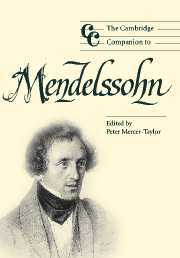Book contents
- Frontmatter
- Introduction: Mendelssohn as border-dweller
- Part I Issues in biography
- 1 Mendelssohn and the institution(s) of German art music
- 2 Mendelssohn and Judaism
- 3 Felix and Fanny: gender, biography, and history
- Part II Situating the compositions
- Part III Profiles of the music
- Part IV Reception and performance
- Notes
- Select bibliography
- Index
1 - Mendelssohn and the institution(s) of German art music
from Part I - Issues in biography
Published online by Cambridge University Press: 28 September 2011
- Frontmatter
- Introduction: Mendelssohn as border-dweller
- Part I Issues in biography
- 1 Mendelssohn and the institution(s) of German art music
- 2 Mendelssohn and Judaism
- 3 Felix and Fanny: gender, biography, and history
- Part II Situating the compositions
- Part III Profiles of the music
- Part IV Reception and performance
- Notes
- Select bibliography
- Index
Summary
By his twenty-first year, Felix Mendelssohn had completed a handful of orchestral and chamber works that placed him among the front ranks of contemporary composers. Yet, as rapidly as a reputation was building around these pieces, it was not as a composer but as a conductor that he made his grand entrance onto the stage of Germany's musical history. On 11 March 1829, he directed the Berlin Singakademie in a revival of Bach's St. Matthew Passion, unheard since its composer's death and thought, in Mendelssohn's time, to have been premiered exactly a century before. Upon receiving word of the event, Goethe famously observed to his friend –Mendelssohn's teacher – Karl Friedrich Zelter, “To me, it is as though I have heard the roar of the sea from a distance.”
The “Bach revival” that feverishly ensued had hardly been conjured ex nihilo by the young conductor: the Singakademie had offered occasional motets and cantatas of Bach's since its 1791 founding, first under the direction of Christian Friedrich Carl Fasch, then, after 1800, under Carl Friedrich Zelter; and by 1829, Bach's generally neglected choral music (his keyboard music had never passed wholly out of currency) had found an important outlet, too, in Frankfurt's Caecilienverein. But there was no question that the 1829 St. Matthew Passion revival – abbreviated though the work was through the excision of six of the chorales, some recitative, and all but two of the arias – constituted an event of epoch-making significance in the revitalization of Bach's reputation.
- Type
- Chapter
- Information
- The Cambridge Companion to Mendelssohn , pp. 9 - 25Publisher: Cambridge University PressPrint publication year: 2004



